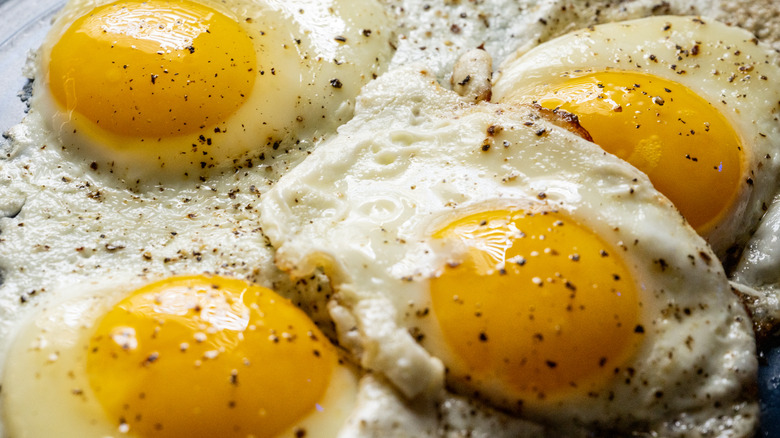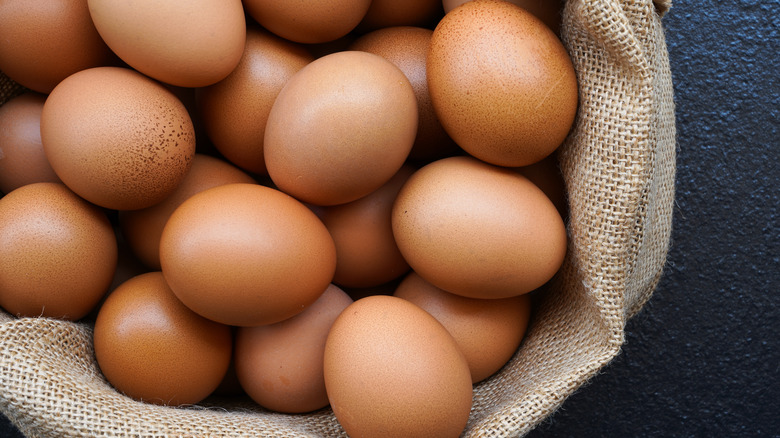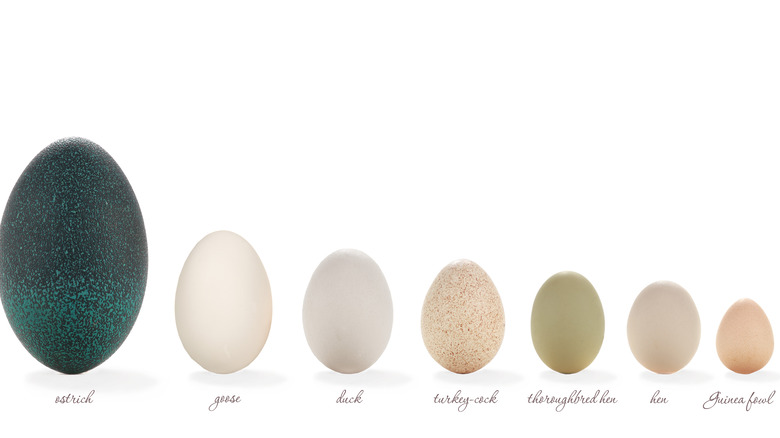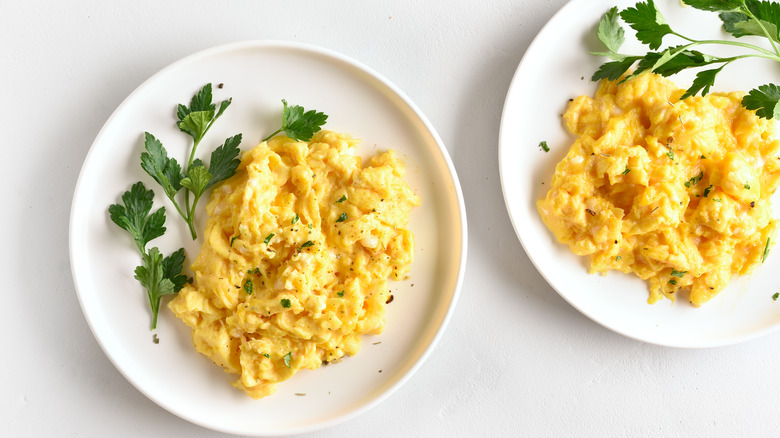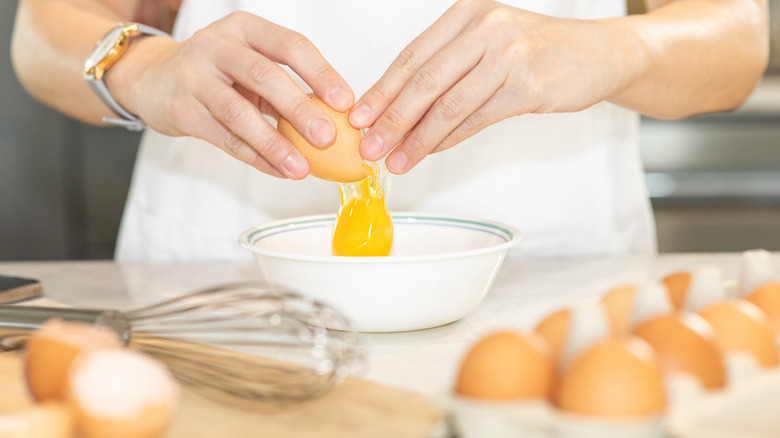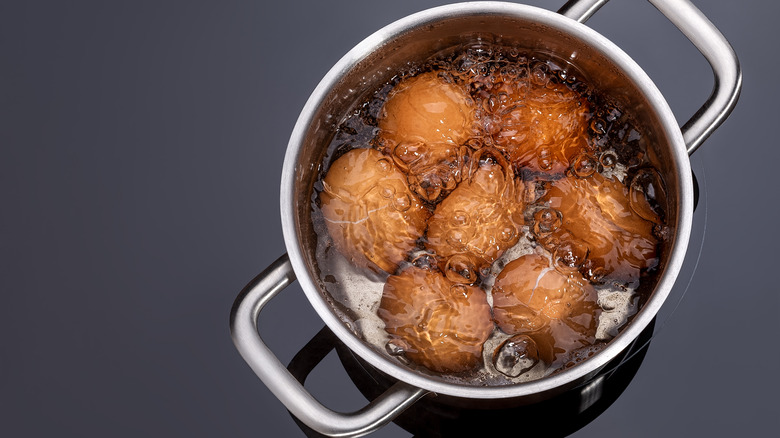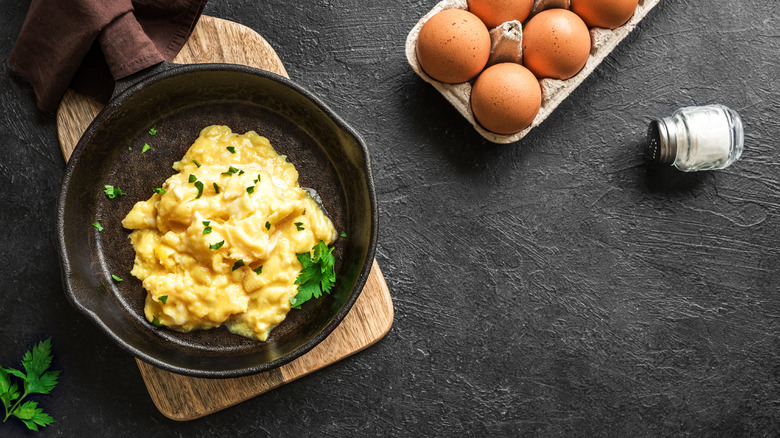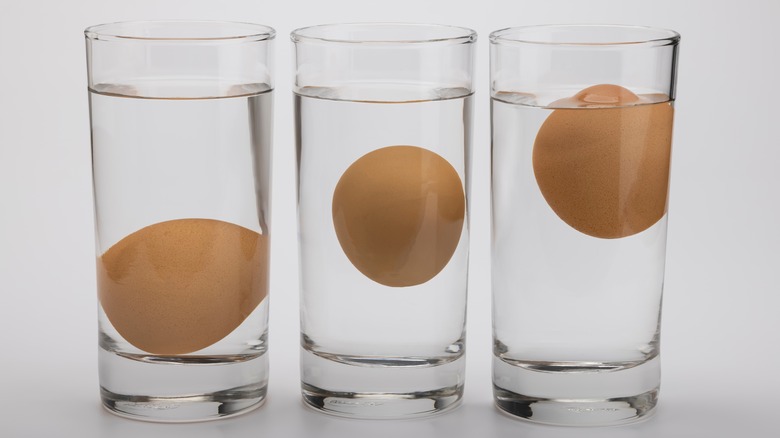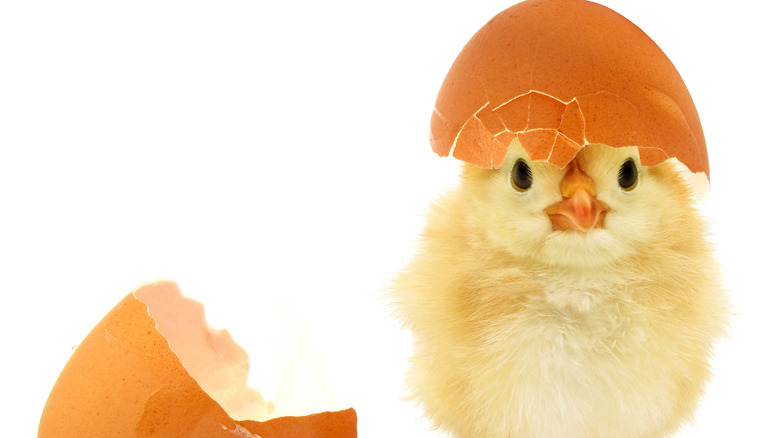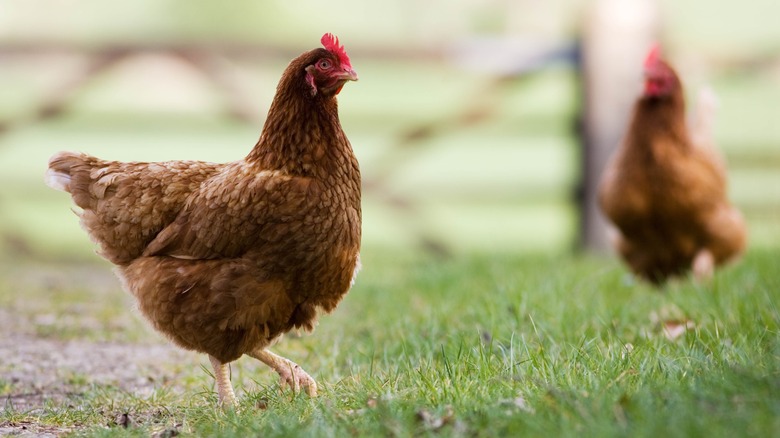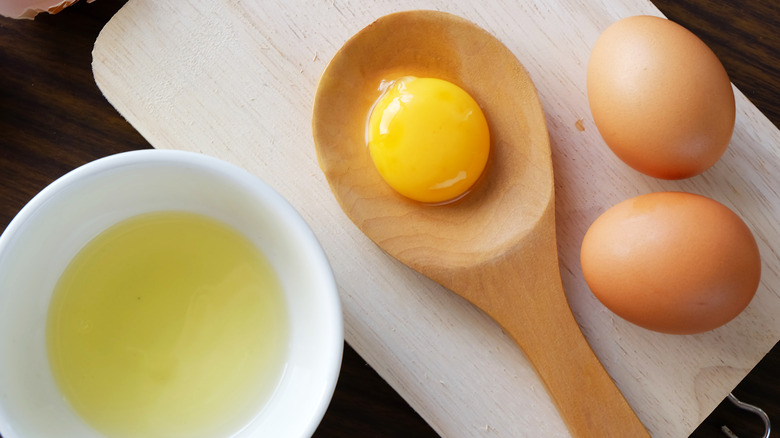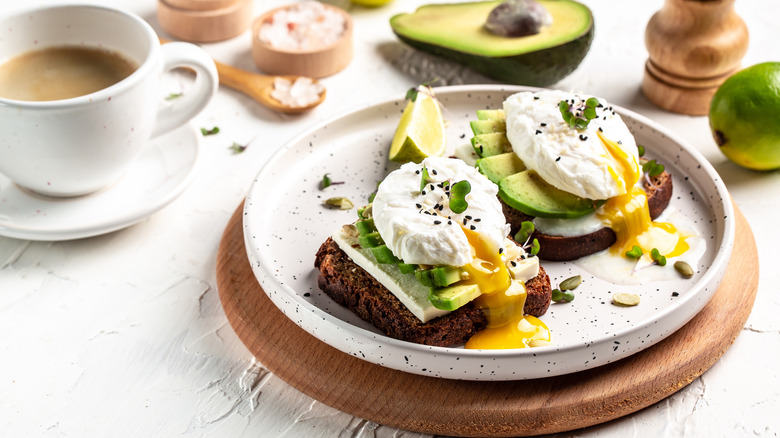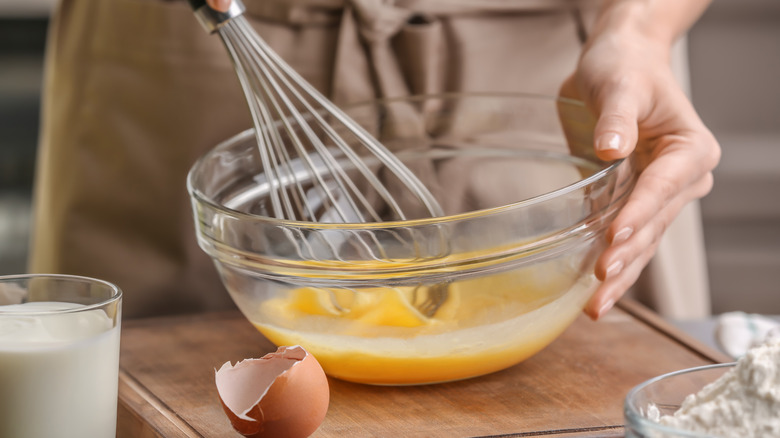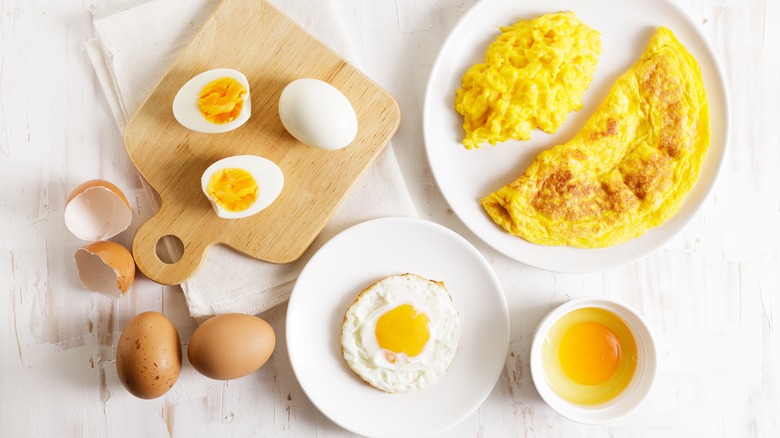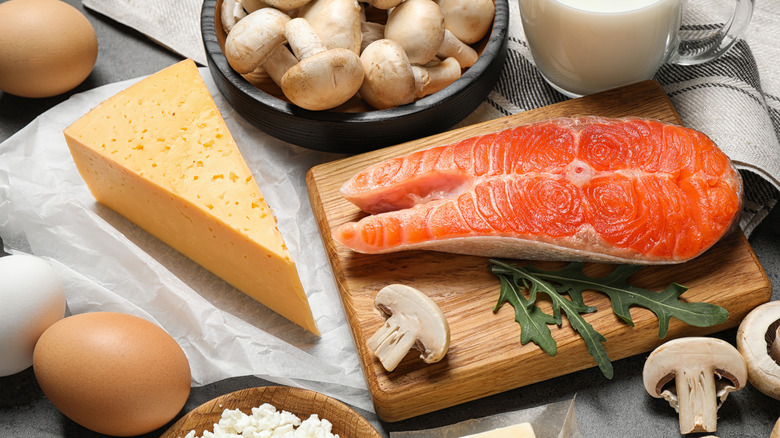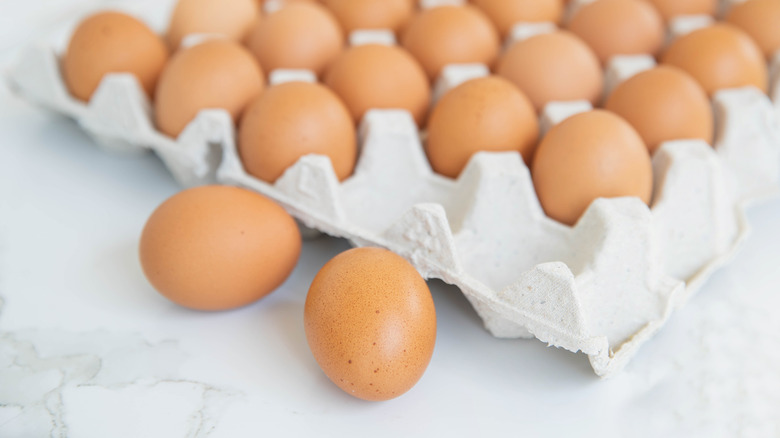Everything You've Ever Wondered About Eggs
The humble egg is one of the most popular breakfast foods worldwide. Whether you like your eggs scrambled, poached, fried, or boiled, we can all agree that there is truly no wrong way to eat this simple food. Many other cooking and baking recipes are dependent on eggs, like oatmeal with an egg for a boost of protein or a warm vanilla loaf cake perfect for a family gathering.
There is a lot of information to know about eggs, including how humans first decided to eat the egg, where the word "egg" comes from, and how most people like to eat eggs. More importantly, you should know how to protect yourself from potential foodborne illnesses living inside your egg carton, as well as some misinformation egg producers use to sway your decision about which egg to buy in the grocery store. We're here to tackle all the egg-cellent information out there, as well as debunk some of the most common egg-related myths.
The average American consumed over 400 eggs in 1945
The year 1945 marked the highest per capita egg consumption in American history at around 404 eggs per person, per the United States Department of Agriculture. After that, egg production slowly declined until the 1990s. The current average egg consumption hovers around an average of 200 eggs per person annually.
On a global scale, Americans are among the top 15 consumers of eggs, according to information from the Helgi Library. The first place consumer is China, where the average person consumes nearly 46 pounds of eggs annually, followed by Mexico at just over 44 pounds annually per person.
You can eat eggs from other birds besides chickens
Although you might not be able to find ostrich eggs in the grocery store, these eggs — which are nearly 20 times the size of an average chicken egg — are available to purchase online or from select farms. Each ostrich egg has a whopping 176 grams of protein according to American Ostrich Farms.
Duck eggs are a little more accessible than ostrich eggs. According to the Cape Coop, duck eggs are about 50% larger than a standard medium chicken egg. The shells on a duck egg are much thicker than a chicken egg and the yolk appears much darker in color. Chefs prize the duck egg over the chicken egg because the white is more stable and the yolk is much fattier.
Scrambled is the most popular way to eat eggs
If scrambled is your go-to egg order at a diner, you can rest knowing you're not the only one. A survey of more than 500 people revealed scrambled was the preferred method of egg preparation; at least 40% of people preferred to cook eggs via scrambling. Some less popular methods include frying and hard-boiling.
One of the reasons scrambled eggs might be the most popular method of preparation is because there isn't much that goes into scrambling eggs. The eggs are merely cracked and broken up in the pan. Different countries have different interpretations of preparing scrambled eggs. Persian eggs are scrambled with dill and feta while Indians prepare Akuri: a scrambled egg spiced with curry, cumin, ginger, cilantro, and lime juice.
Not everyone refrigerates eggs
It's uncommon to see eggs outside of the refrigerator in most American homes. But many countries globally do not refrigerate eggs because the eggs are fresh and still have an intact protective cuticle on the eggshell. American producers wash eggs prior to sale to remove any harmful bacteria, like salmonella, thus requiring refrigeration to keep the eggs safe for human consumption, according to Insider. If you purchase eggs from a small farmstand (and can ask if the eggs have been washed or not) or have your own flock, you do not need to refrigerate your eggs — so long as the eggs are not washed off. As mom always said, "a little dirt don't hurt!"
There is a difference between white and brown eggs
If you've purchased eggs at a local grocery store, you've probably wondered about the difference between white and brown eggs. The difference is actually much more simple than you'd think. White chickens with white earlobes, such as Silkies and Leghorns, lay white eggs. Chickens with red or brown feathers and red earlobes, like Rhode Island Reds, Plymouth Rocks, and Brahmas, lay brown eggs. According to Healthline, there is no difference in the nutritional qualities of white or brown eggs, nor are there differences in the texture or appearance of the eggs (besides the shell). Brown eggs tend to be slightly more expensive than white eggs because brown chickens breeds are slightly larger and require more feed.
There is a simple way to remove eggshells from a bowl
Imagine this: You're making cookies and notice a tiny sliver of eggshell drop into the bowl. Although you can try to chase the shell around the bowl with your finger, there is a more simple way to remove eggshell pieces from cracked eggs. First, dip your fingers in water. This will cause the eggshell to stick to your fingers and easily retract from the egg whites. In the future, you might want to use a smaller bowl to prevent losing eggshell shards in your dinner. If you're separating yolks from the whites, you might pour the whole egg into a separate bowl first.
Drop eggs into boiling water for easier peeling
It's not uncommon to peel a hard-boiled egg and have pieces of eggshell stick to the white. This simple egg-peeling trick is guaranteed to make the process a thousand times easier. J. Kenji Lopez-Alt recommends dropping eggs directly into boiling water rather than having the eggs start in cold water and heat up as the water boils. It is also important to make sure the eggs cool completely before peeling. The cooling process allows the whites to separate from the shell. Cooling takes about 15 minutes, but can be accelerated by placing the eggs in the fridge.
A chemical reaction causes cooked eggs to turn green
The color green is generally a sign of spoilage. But is the same true for eggs?
According to the American Egg Board, scrambling eggs in a cast iron pan can cause the eggs to change color. This is because of an interaction between the sulfur in the egg whites and the iron in the pan. A similar reaction occurs between the sulfur in the egg whites and the iron in the yolk. It is most likely to occur when the eggs have been cooking for too long or at too high a heat. There are no adverse health effects associated with consuming eggs that have experienced this reaction.
Test if your eggs are fresh by dropping each into a glass of water
Dropping a fresh uncooked egg into a glass of water is a simple egg hack that can tell you how fresh your egg is. If the egg either settles on its side or the bottom of the glass, the egg is fresh and fine to eat. If the egg floats, you'll need to throw it away. According to What's Cooking America, there's cool science behind egg buoyancy. As an egg ages, an air cell inside the egg increases in size as oxygen permeates the shell. This causes the egg to be buoyant once placed in water.
The egg yolk and white provide a healthy serving of fat and protein
Eggs are well-recognized for their nutrition. According to the American Egg Board, eggs are one of the most affordable, complete sources of protein. This means that the egg contains all of the essential amino acids the human body needs to consume. The yolk has more protein than the white by weight, but eggs contain more whites than yolks — so egg whites are commonly considered the egg's protein epicenter. While egg whites do not contain fat, the yolk contains a high level of monounsaturated fat that helps maintain the body's cholesterol levels.
Humans have consumed eggs for thousands of years
The practice of eating eggs dates back thousands of years, according to Food Timeline. Eggs have been the subject of many religious traditions and their nutritional value makes them an excellent pre-fasting food. Historians believe early societies started realizing their members could slaughter some of the male birds for meat and leave the female birds (hens) for eggs. It is estimated that the first egg-producing fowl were domesticated around 6,000 B.C. in China.
Eggs were not used for baking until after the domestication of fowl. There is no clear answer on how people recognized enriching dough with ingredients like eggs, butter, and cream would alter the taste — but most historians assume it was a trial-by-error.
Eggs are sold in a dozen for a reason
One of the most common questions surrounding eggs is who decided to make a dozen 12 rather than any other number. According to reporting by The New York Times, this measurement system developed after the Romans arrived in England in the first century. The English unit system combined existing Anglo-Saxon and Roman measurement systems in which one egg could be purchased for a penny — or 12 eggs for a shilling (equivalent to 12 pennies). Although this measurement system was abandoned in 1824, dozens stuck around in America and Europe. In some countries in Africa and Asia, it is normal to purchase single eggs or packs of eight to 10.
You can tell if an egg is fertilized by looking at the yolk
You might have always been curious about how to tell if you are eating a fertilized egg or not. Fertilized eggs will include a small disc on the yolk, about 4 millimeters wide. This is the germinal disc, and its' presence indicates that the sperm and the egg have met. If the egg is incubated, the disc will continue to grow and divide to form a chick.
Although blood spots are commonly thought to be the early stages of embryo development, these spots are actually just a benign blood vessel rupture. In fact, the blood spot is actually indicative of a fresh egg; as the egg ages, the blood spot will dissolve into the white.
Cage-free and free-range eggs aren't what you think they are
According to the Humane Society of the United States, there is no regulation on the labeling of eggs outside of the word "organic." Organic eggs (and the feed used to sustain the birds) must be produced without the use of many synthetic pesticides and chemicals. Organizations must seek organic food certification and undergo a rigorous testing process to receive that distinction.
"Cage-free" or "free-range" eggs, on the other hand, are not regulated. Several organizations, including the Humane Society, offer voluntary certifications that mandate a certain amount of space per bird, minimum outside time for birds, and similar requirements. The United Egg Producers Certification, for example, allows producers to cut the beaks of birds to inhibit pecking. The "cage-free" distinction from the same certifying organization increases the size to 144 square inches per hen and mandates that all birds must be kept out of cages, but indoors always. Free-range certification from Certified Humane requires all free-ranged birds to have at least two square feet of space outside per bird (no vegetation required) and at least six hours outside per day.
No chicken eggs will contain hormones
The use of hormones in egg production was banned in the 1950s, according to an article by the United Egg Producers. The nature of poultry farming makes the administration of growth hormones unpractical as well as expensive for producers. The label "no hormones added" on egg containers is nothing more than a marketing gimmick.
So what about antibiotics? There is very little evidence that links consuming eggs with consuming antibiotics given to hens. Speaking broadly, producers have placed special emphasis on biosecurity practices and operating procedures that limit the spread of bacteria and viruses among flocks. While organic certification does not allow for the use of most synthetic antibiotics on any layers, some non-organic farms will use antibiotics under the direction of a veterinary professional.
The color of an egg yolk does not indicate nutritional value
The color of an egg yolk has little to do with its nutritional benefits. The color of the yolk is more dependent on the pigments the chickens eat; hens fed yellow corn or alfalfa will have more yellow yolks than hens fed white cornmeal. Since American consumers prize a dark yellow yolk, many hens are fed artificially-colored feed to boost the amount of orange pigments in the chickens' diet. Some producers use marigold petals to increase pigment, while non-organic operations may resort to adding synthetic dyes.
There's not much scientific evidence to back the idea that darker yolks have a different flavor, but we'll let you be the judge on that one.
Grade AA eggs have the firmest whites, thus are best for poaching
Eggs are given size grades based on the weight of the dozen rather than the weight of an individual egg. These sizes include peewee (15 ounces) to jumbo (30 ounces). Most eggs in the grocery store are large (24 ounces) or extra large (27 ounces).
The USDA can also administer individual shell grades based on the quality and sanitation of the egg. This evaluation is a voluntary, paid service and provides producers with one of three grades: AA, A, or B. B eggs are the least fresh and primarily used for egg products and egg powders while A eggs are deemed "high quality." AA eggs are the freshest eggs available with the least amount of cosmetic defects. According to MasterClass, eggs with an AA certification should be used for foods where appearance is very important, such as eggs Benedict or poaching.
Eating raw eggs isn't any healthier than eating cooked eggs
Eating raw eggs are often seen as the peak of masculinity. But how beneficial is it really? And is it safe to eat raw eggs?
According to the Cleveland Clinic, eating raw eggs does not have any greater nutritional benefit than eating cooked eggs. Food scientists recommend pasteurized eggs and egg products for all raw uses, such as hollandaise or aioli. Pasteurization kills salmonella and other bacteria that can make us sick.
So although you could eat a raw egg, you should really stick to cooked eggs for a lesser risk of exposure to foodborne illness. And why would you want to experience the slimy, gelatinous whites anyways? We'll stick to scrambled.
Happy hens produce better eggs
It's no surprise that happy hens produce more — and better quality — eggs. Hens are very reactive toward the environment and will not lay eggs under stressful conditions. Research from the University of Australia has shown that free-range hens produce more eggs than confined birds and also exhibit a greater vitality. Country Homestead Living also notes that free-range birds have a longer lifespan than confined animals and have less exposure to diseases like egg drop syndrome. This data, along with data examining the quality of food fed to hens, further demonstrates that food production and animal welfare can coincide with one another.
The word egg originated in Norse or Indo-European language
How did we settle on the word "egg?" Egg comes from the Old English word, aeg. The word started appearing in English print during in the 1500s after the Vikings had traveled to modern Britain during the 1000s. It wasn't until the Elizabethan era when the spelling for egg became standardized as it is known today. Variations of the word "egg" were used in literature and culture; Shakespeare used "egge" to convey disdain in his play, "Macbeth." Later on, phrases of speech like "good egg" and "bad egg" came into use, as well as idioms like "don't put all your eggs in one basket" — which came from Miguel de Cervantes' "Don Quixote," published in 1615.
The part of the egg that holds the salmonella bacteria is the shell
There is a lot of confusion surrounding salmonella and eggs. According to the Centers for Disease Control and Prevention, egg shells can become contaminated with salmonella when hens pass eggs or the eggs touch chicken droppings. Salmonella can also be transferred from the chicken to the egg while the egg is developing, but this is much less likely.
Salmonella can be transmitted to humans when the eggs are improperly handled or the bacteria comes into contact with other foods. Recent studies have indicated that less than half of adults wash their hands after cracking eggs, which can spread salmonella from egg shells to other food products. For best practices, you should wash your hands before and after handling raw eggs, as well as avoid cross-contaminating raw eggs with other kitchen surfaces.
The best way to crack an egg is on a hard, flat surface
You should always crack an egg on a hard surface. Unlike cracking an egg on the corner of a dish, cracking the egg on a hard surface will allow the membrane to remain intact. The smaller shell fragments will remain connected rather than shattering into the bowl and resulting in more headaches for the home cook. Cracking eggs on the corner of a bowl will also lessen the risk of bacteria transfer since less of the egg is touching the shell's exterior. This method is a fool-proof way to keep your egg intact and your body safe.
Eggs are one of the only foods containing vitamin D
The yolk of the egg is literally liquid sunshine. According to the International Egg Commission, eggs are one of the only dietary sources of vitamin D. Vitamin D is important in regulating skeletal health, bone development, and muscle health. Most humans obtain vitamin D through exposure to sunlight, but this nutrient can also be obtained through a limited number of foods. Although obtaining vitamin D through exposure to sunlight is very important, supplementing vitamin D uptake with dietary sources including eggs, oily fish, and mushrooms is recommended. Such is especially true for individuals who must avoid sunlight or those who do not receive adequate environmental exposure to the vitamin.
Eggs are good after the sell-by date
Eggs have a comparatively long shelf life compared to other animal products. The USDA claims eggs can be refrigerated up to three- to five-weeks after purchase. Although the sell-by date typically occurs during that three to five week window, the eggs are usually still perfectly fine to eat. To optimize storage time, keep the eggs in the original carton and store in the coldest part of your refrigerator. The door is not an ideal place to store eggs because of the dramatic temperature changes from opening and closing the refrigerator. Eggs will last about a week in the fridge after being hard boiled.
The white strings in the egg help hold the egg structures in place
The white strings in between the yolk and the egg are proteins called chalaza or chalazae. The purpose of these strings is to keep the yolk suspended and safe in the eggshell during the development of the chick. These protein strands are completely edible and have a negligible impact on the taste and texture of the surrounding egg. If you're preparing a meringue, you can strain the chalaza out of the whites for a smoother texture.
In fact, a prominent chalaza is indicative of a fresh egg. The lack of a chalaza may reflect an old egg, so be sure to check the carton for the sell-by date.
